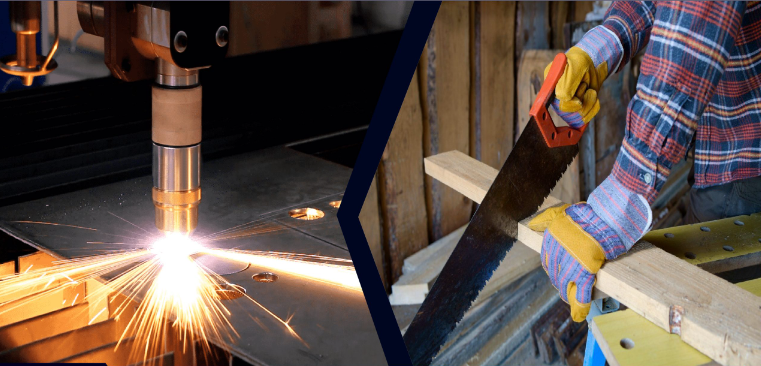
- English
- Español
- Português
- русский
- Français
- 日本語
- Deutsch
- tiếng Việt
- Italiano
- Nederlands
- ภาษาไทย
- Polski
- 한국어
- Svenska
- magyar
- Malay
- বাংলা ভাষার
- Dansk
- Suomi
- हिन्दी
- Pilipino
- Türkçe
- Gaeilge
- العربية
- Indonesia
- Norsk
- تمل
- český
- ελληνικά
- український
- Javanese
- فارسی
- தமிழ்
- తెలుగు
- नेपाली
- Burmese
- български
- ລາວ
- Latine
- Қазақша
- Euskal
- Azərbaycan
- Slovenský jazyk
- Македонски
- Lietuvos
- Eesti Keel
- Română
- Slovenski
- मराठी
- Srpski језик
Sawing vs Laser Cutting Technology: How to Choose
2024-03-20
Choosing sawing or laser cutting technology depends on a variety of factors, including material type, processing requirements, budget, production efficiency, and more. Here are some suggestions to help you make an informed choice between the two technologies:

Material type
Sawing: Suitable for thicker, larger or composite materials, such as wood, large pieces of metal, etc.
Laser cutting: suitable for thin and precise materials such as metal sheets, plastics, and glass.
Cutting accuracy requirements
Sawing: If your requirements for cutting precision are not particularly high and your budget is limited, sawing may be a suitable option.
Laser cutting: In scenarios that require high-precision cutting, such as electronic parts manufacturing, precision machinery, etc., laser cutting can better meet the requirements.
Productivity and speed
Sawing: Sawing speeds may be reduced when working with large, thick materials, but productivity can be increased by using more powerful sawing equipment.
Laser Cutting: Laser cutting is faster in most cases and is particularly suitable for production environments that require high throughput.
Cost of investment
Sawing: Sawing equipment is usually simple and has relatively low investment costs, making it suitable for situations where the budget is limited.
Laser cutting: Laser cutting equipment is generally more expensive and requires a larger initial investment.
Material waste
Sawing: Due to the characteristics of the saw teeth, more waste material may be generated during sawing. In some environments where material waste requirements are high, careful consideration is required.
Laser Cutting: Laser cutting generally produces less waste because it is a non-contact cutting method.
Operation and maintenance difficulty
Sawing: The operation is relatively simple and the operator's skill requirements are relatively low. Maintenance mainly includes saw blade replacement and equipment cleaning.
Laser Cutting: Operation and programming may require a high level of skill, with complex equipment maintenance and calibration requirements.
Safety and environmental impact
Sawing: Sawing produces noise and vibration due to the mechanical movement involved. These factors need to be considered in certain situations where there are requirements for the working environment and operator health.
Laser cutting: usually produces less noise, but attention needs to be paid to the impact of laser radiation and exhaust gases on the environment and operators.



